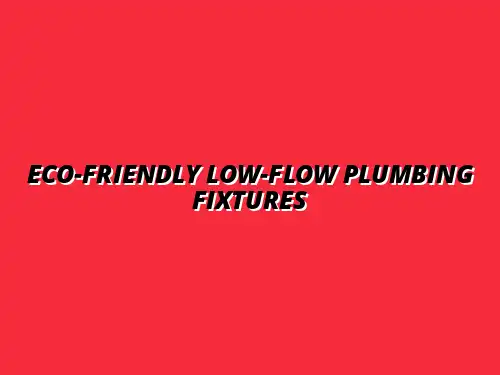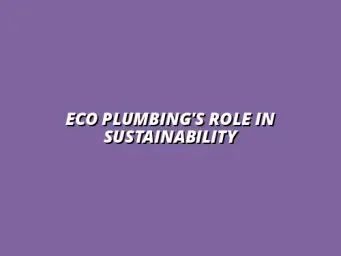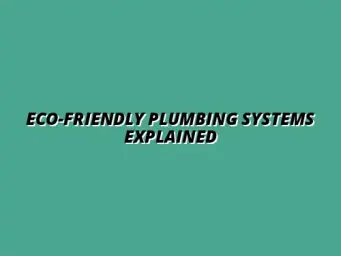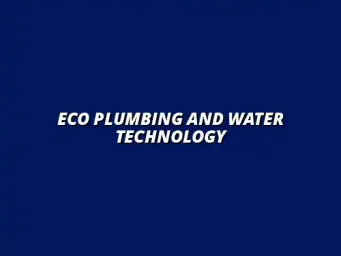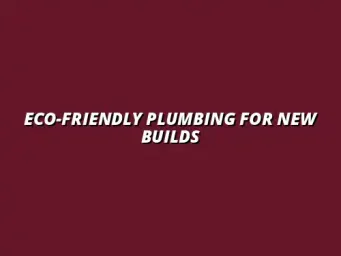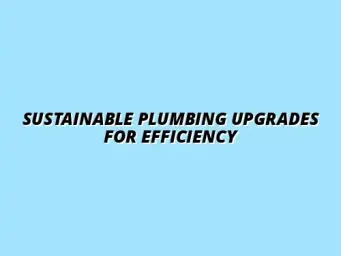Understanding Low-Flow Plumbing Fixtures and Their Importance
Low-flow plumbing fixtures are becoming essential in modern households. They are designed to use significantly less water than traditional fixtures while still maintaining performance. By understanding these fixtures, we can appreciate their role in promoting water conservation and the overall health of our planet!
Defining Low-Flow Plumbing Fixtures
Low-flow plumbing fixtures include toilets, faucets, and showerheads that are engineered to reduce water usage. These fixtures are a part of a broader effort to conserve water, which is a precious resource. By adopting low-flow options, we can make a big difference in our everyday water consumption. Learn more about the benefits of low-flow toilets for water conservation and how they contribute to sustainable living.
What Are Low-Flow Toilets, Faucets, and Showerheads?
Low-flow toilets use around 1.6 gallons per flush, compared to the standard 3.5 gallons or more. Faucets and showerheads typically have flow rates of 1.5 gallons per minute or lower. Here’s a quick breakdown of each:
- Low-Flow Toilets: Designed for efficient flushing.
- Low-Flow Faucets: Limit the amount of water used while washing hands or dishes.
- Low-Flow Showerheads: Provide a satisfying shower experience while using less water.
The Technology Behind Low-Flow Water Efficiency
The technology in low-flow fixtures often involves advanced designs that optimize water flow. Features like aerators for faucets introduce air into the water stream, reducing the overall flow without sacrificing pressure. This innovation is crucial for keeping daily routines effective while conserving water. For essential kitchen plumbing maintenance tips that can also contribute to water conservation, check out this helpful guide: Essential Kitchen Plumbing Maintenance Tips.
The Role of Low-Flow Fixtures in Water Conservation
Low-flow fixtures play a vital role in reducing the overall water footprint of households. By choosing these fixtures, we contribute to larger conservation efforts that are essential for sustainable living. Let's look at some important statistics to understand the impact!
Statistics on Water Usage in Households
Households are among the largest consumers of water, with a significant percentage used for bathing, cooking, and cleaning. Here are some interesting stats:
- On average, a family of four uses about 400 gallons of water per day.
- Bathrooms account for approximately 75% of indoor water usage!
- Replacing old fixtures can save households hundreds of gallons of water each month.
How Much Water Can Be Saved with Low-Flow Fixtures?
Switching to low-flow fixtures can lead to remarkable savings in water use. For instance, installing low-flow toilets can save up to 13,000 gallons of water per year for a typical household. Regular checks on your bathroom water heater can help prevent leaks and save water. Learn more about this crucial step in Regular Bathroom Water Heater Checks. Here are other potential savings:
- Low-flow showerheads can save around 2,900 gallons annually.
- Low-flow faucets reduce water use by approximately 700 gallons per year.
Eco-Friendliness and Its Connection to Water Conservation
Water conservation is closely tied to eco-friendliness. Adopting low-flow plumbing fixtures is a step towards creating a more sustainable home. It’s essential to understand how our choices impact the environment! Discover more about the benefits of eco-friendly plumbing for homeowners and how it contributes to a greener lifestyle.
Understanding Eco-Friendly Practices in Home Design
Eco-friendly home design emphasizes reducing resource consumption and minimizing waste. By selecting low-flow fixtures, we contribute to this sustainable practice. Key elements of eco-friendly design include:
- Using renewable materials.
- Incorporating energy-efficient appliances.
- Implementing water-saving technologies like low-flow fixtures.
The Environmental Impact of Water Waste
Water waste has severe environmental consequences, including depletion of freshwater resources and harm to aquatic ecosystems. By reducing water usage through low-flow fixtures, we can help preserve these vital resources. Every drop counts, and it's crucial for us to be aware of our water consumption habits! Learn more about simple water-saving tips for homeowners to make a difference.
Advantages of Choosing Low-Flow Plumbing Fixtures
Choosing low-flow plumbing fixtures comes with many benefits. Not only do they help the environment, but they can also reduce costs for homeowners. Here are some main advantages to consider!
Reducing Water Bills for Homeowners
One of the most immediate benefits of low-flow fixtures is the reduction in water bills. As we use less water, our monthly expenses decrease. This can lead to significant savings over time!
Long-Term Benefits for the Environment
Low-flow fixtures contribute positively to the environment by conserving water and promoting sustainable practices. Preventing water heater leaks is crucial for both cost savings and environmental responsibility. Find out how with this guide: Prevent Water Heater Leaks Easily. Over time, widespread adoption of these fixtures can lead to improved water quality, healthier ecosystems, and a more sustainable future. It’s a win-win for everyone!
Common Misconceptions About Low-Flow Fixtures
Despite their benefits, low-flow fixtures still face some misconceptions. Many people worry that these fixtures compromise performance or are difficult to install. Let's clear up these misunderstandings!
Do Low-Flow Fixtures Compromise Performance?
One common myth is that low-flow fixtures don’t perform as well as traditional ones. In reality, modern low-flow toilets, faucets, and showerheads are designed to provide excellent performance while using less water. They undergo rigorous testing to ensure efficiency without sacrificing user experience!
Myths Surrounding Installation and Maintenance
Some believe that low-flow fixtures are hard to install or require constant maintenance. This isn’t true! Many low-flow fixtures can be installed easily by homeowners, and they typically require the same maintenance as regular fixtures. Embracing low-flow technologies is easier than ever!
Applying Low-Flow Solutions in Your Home
Making the switch to low-flow plumbing fixtures can be a fantastic way to conserve water and save money. However, before diving in, it’s essential to identify the right fixtures that suit your needs. With various options available, understanding what to look for in low-flow toilets, faucets, and showerheads can help ensure you make an informed decision.
Above all, consider your household's water usage patterns. For instance, families with children may have different requirements than single-person households. By understanding your specific needs, you can select fixtures that not only save water but also provide optimal performance and comfort. For information on professional plumbing services in Selly Oak, Birmingham, visit: Plumber in Selly Oak, Birmingham.
Identifying the Right Low-Flow Fixtures for Your Needs
When searching for low-flow toilets, there are several key features to consider to ensure efficiency and effectiveness. Here are some important factors:
- Flush Rate: Look for toilets that use 1.28 gallons per flush (GPF) or less.
- Dual Flush Options: These allow you to choose between different flush rates based on waste type.
- WaterSense Certification: Fixtures with this label meet specific water efficiency criteria.
Choosing Efficient Faucets and Showerheads
Faucets and showerheads also play a significant role in water conservation. When selecting these fixtures, aim for the following features:
- Flow Rate: Faucets should ideally flow at 1.5 gallons per minute (GPM) or less, while showerheads should be at 2.0 GPM or less.
- Low-Flow Technology: Look for aerators that mix air with water, allowing for a fuller stream without using more water.
- Easy-to-Use Controls: Ensure that the controls are user-friendly for everyone in the household.
By focusing on these features, you can choose efficient fixtures that help reduce water consumption while maintaining comfort and functionality.
Installation Tips and Considerations
Once you’ve selected your low-flow fixtures, the next step is installation. You can choose between DIY installation or hiring a professional, depending on your skills and comfort level. Here are some factors to consider:
- Skill Level: If you’re comfortable with basic plumbing tasks, you might save on labor costs by doing it yourself.
- Tools Required: Make sure you have the necessary tools, such as wrenches and pliers, before starting the installation.
- Time Commitment: Factor in how long the installation process might take, especially if you’re new to plumbing projects.
Potential Challenges and How to Overcome Them
One common challenge can be old plumbing systems that don’t connect smoothly with new fixtures. To avoid complications:
- Check for the compatibility of existing pipes with the new fixtures.
- Inspect for leaks once installed.
- Have a backup plan for professional help if you encounter difficulties.
Taking these precautions can help ensure a smoother installation experience, whether you do it yourself or hire a professional.
Real-Life Examples and Case Studies
Seeing real-life examples of successful water conservation projects can inspire you to embrace low-flow fixtures in your home. Many communities have implemented low-flow initiatives that yielded impressive results. Here are a few notable projects:
- Community Programs: In cities like San Francisco, water-saving campaigns have led to significant reductions in overall consumption.
- Household Upgrades: Many homeowners have reported a 30% to 50% decrease in their water bills after switching to low-flow fixtures.
- School Installations: Schools that adopted low-flow toilets and faucets have seen both financial savings and environmental benefits.
Testimonials from Homeowners and Environmentalists
Many homeowners and environmental advocates have shared positive feedback on the transition to low-flow fixtures. Here's what they are saying:
- Homeowners love the savings on their utility bills.
- Environmentalists appreciate the reduction in water waste and the positive impact on local ecosystems.
- Many report that performance is on par or better than traditional fixtures.
These testimonials highlight just how effective low-flow plumbing can be in both residential and community settings.
Addressing Frequently Asked Questions
As you consider low-flow fixtures, you may have some questions. Understanding the cost implications is crucial for making a wise choice. Here are some common inquiries:
What Are the Cost Implications of Low-Flow Fixtures?
Initially, low-flow fixtures may have a higher upfront cost, but they often pay off quickly through reduced water bills. On average:
- Low-flow toilets can save you up to $100 a year.
- Low-flow showerheads and faucets can contribute to similar savings.
- The average payback period for these fixtures is usually less than three years.
How Do Low-Flow Fixtures Affect Water Pressure?
Many people worry that switching to low-flow fixtures will lead to decreased water pressure. However, modern low-flow technologies are designed to maintain strong pressure while reducing consumption. You might even find:
- Improved performance due to better aeration in faucets.
- Balanced pressure that feels just as satisfying as traditional fixtures.
- Greater overall comfort in your daily routines.
Ultimately, low-flow fixtures can effectively manage water pressure while still conserving valuable resources.
Encouraging Eco-Friendliness Beyond Plumbing
Switching to low-flow fixtures is just one step toward making your home more eco-friendly. Here are additional eco-friendly home improvements you can consider:
- Energy-Efficient Appliances: Replace old appliances with Energy Star-rated models.
- Rainwater Harvesting: Set up systems to collect and use rainwater for irrigation.
- Smart Home Technology: Use smart devices to monitor and reduce energy and water usage.
Community Initiatives Supporting Water Conservation
Getting involved in community initiatives can amplify your efforts. Many local organizations promote awareness and provide resources for water conservation. Look for:
- Workshops on sustainable practices.
- Community clean-up events focused on local waterways.
- Incentives for installing water-saving technologies in your home.
By participating, you can help spread the word about the importance of conserving water.
Final Thoughts on Embracing Low-Flow Plumbing for a Greener Future
In summary, embracing low-flow plumbing fixtures offers a multitude of benefits. Not only do they save water and money, but they also contribute to a healthier environment. When you choose to install these fixtures, you're taking a significant step toward sustainability.
Encouraging Action: Making the Switch to Low-Flow Solutions
Now is the perfect time to evaluate your home’s plumbing. Assess which fixtures you can replace with low-flow options, and join the movement toward a more sustainable future! Every effort counts, and you’ll be proud to contribute to water conservation efforts while enjoying the benefits of lower utility bills!

